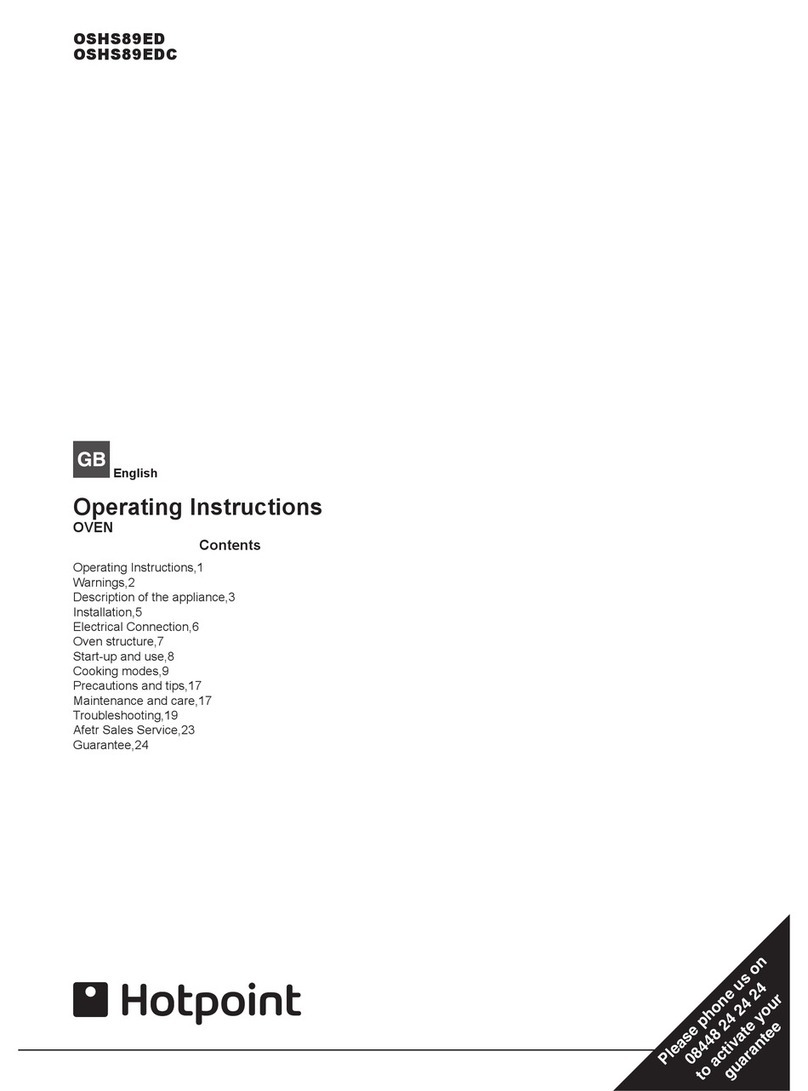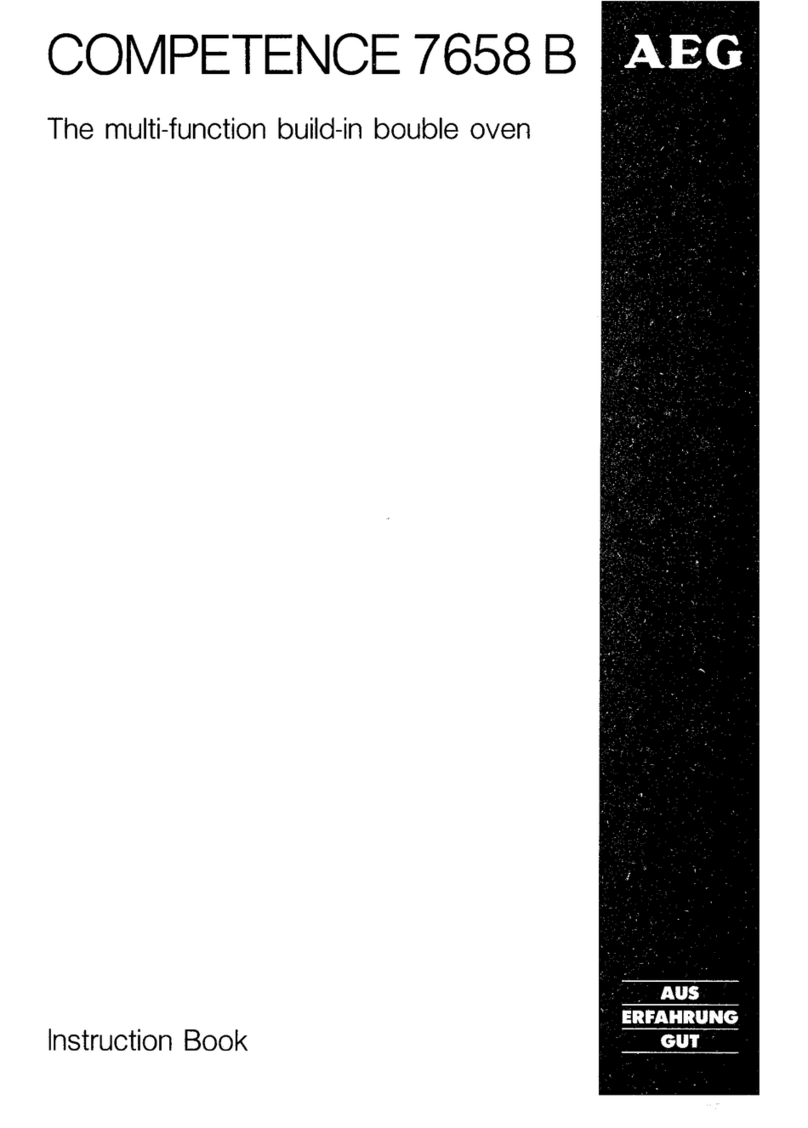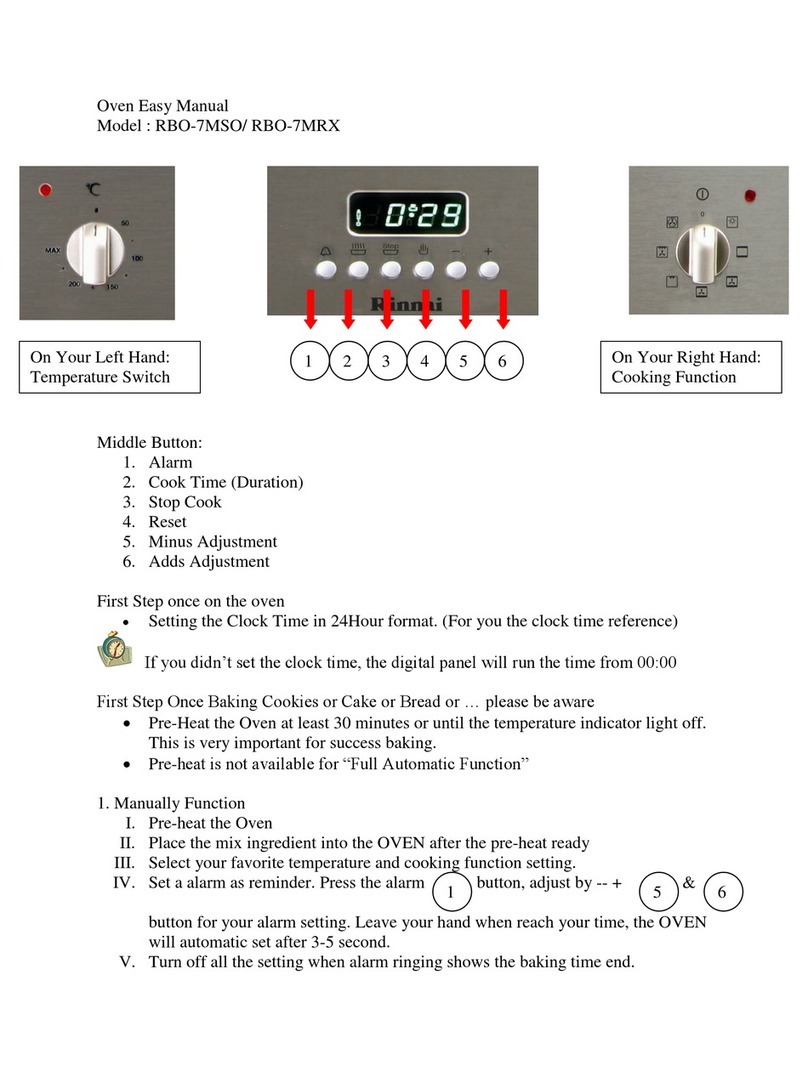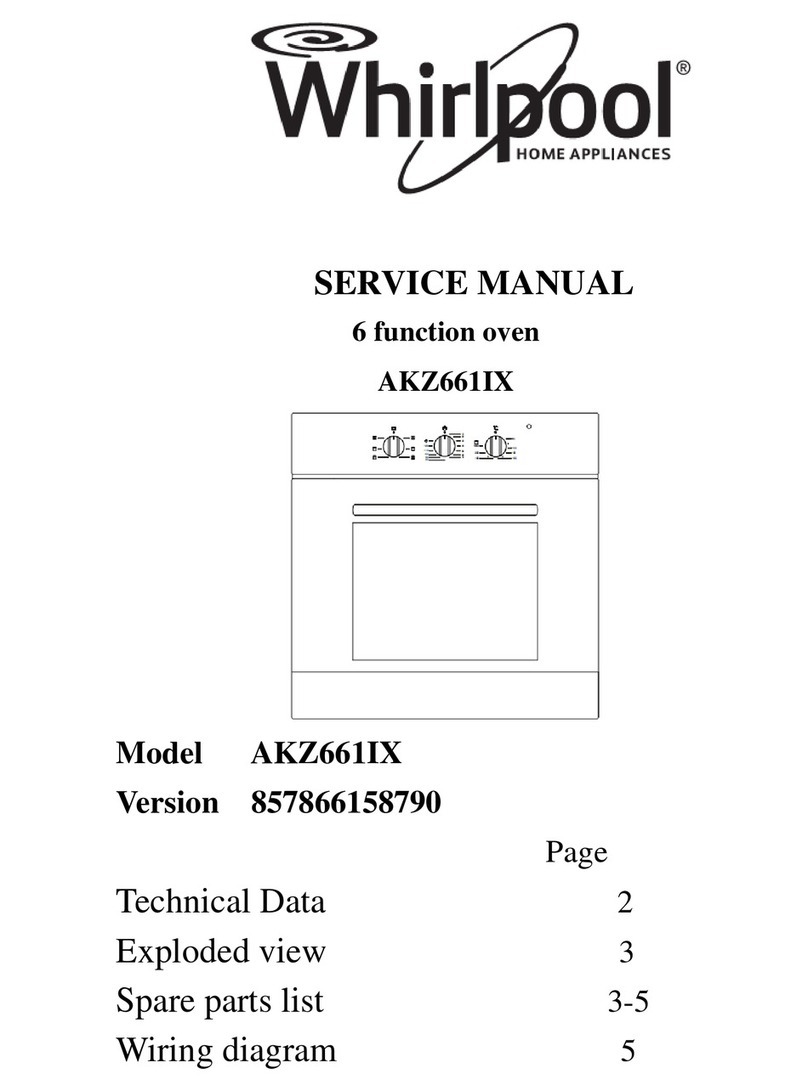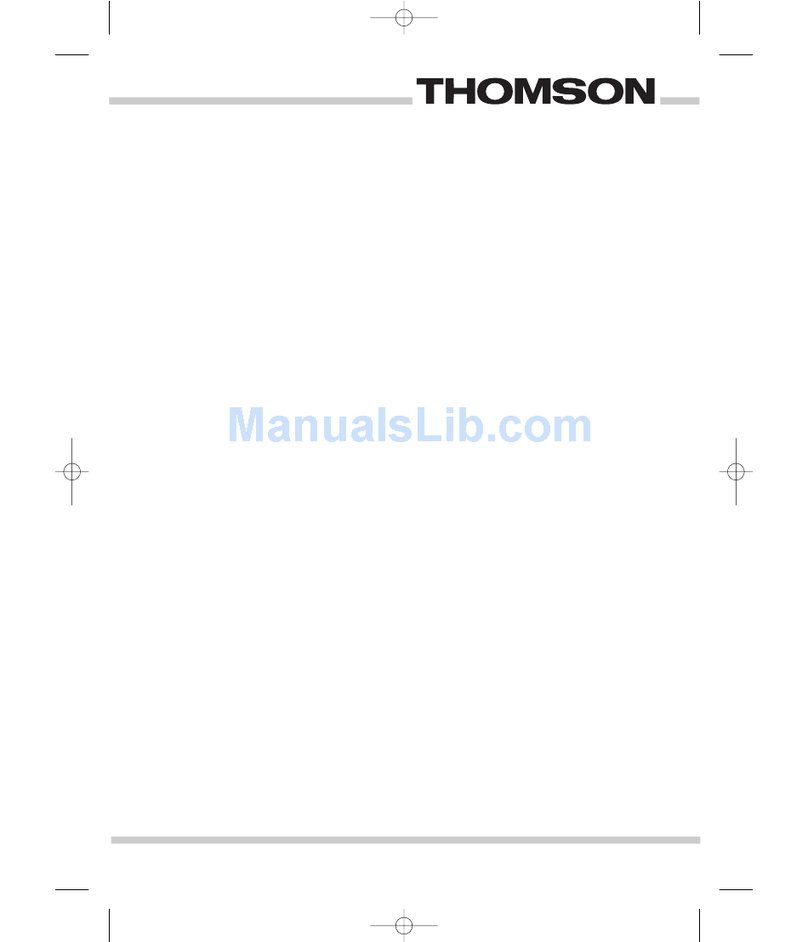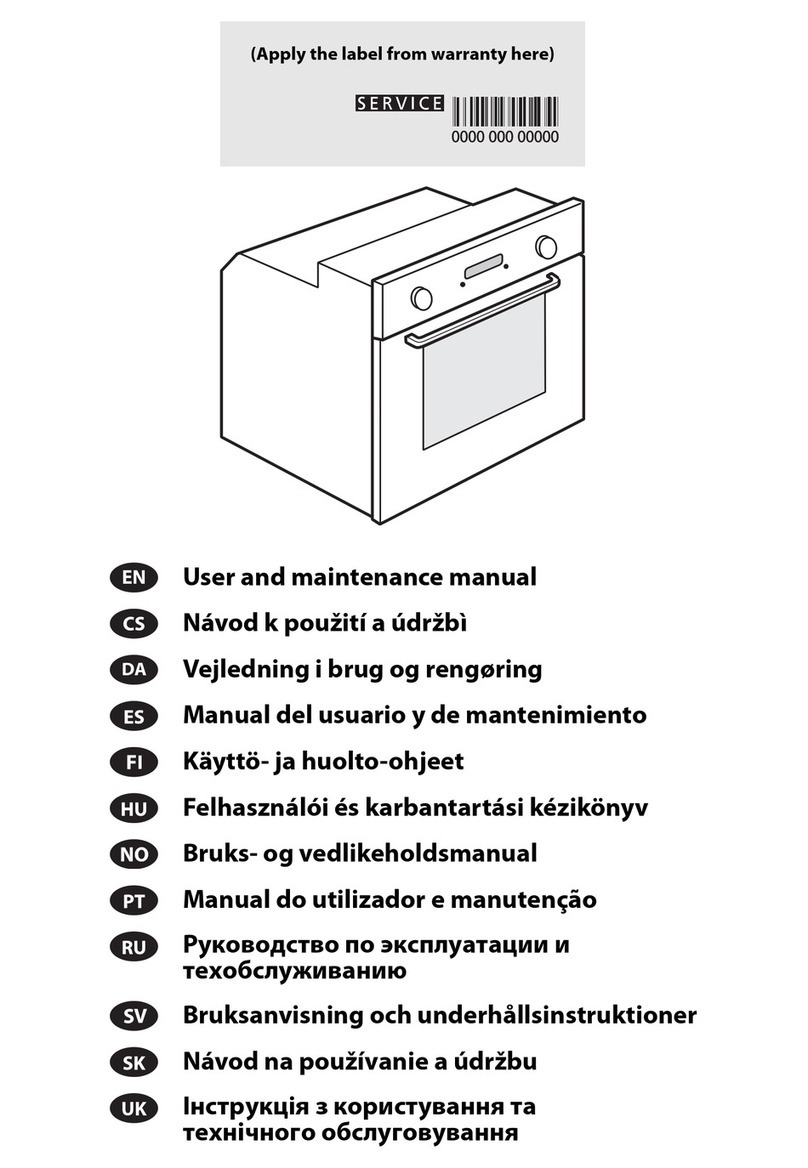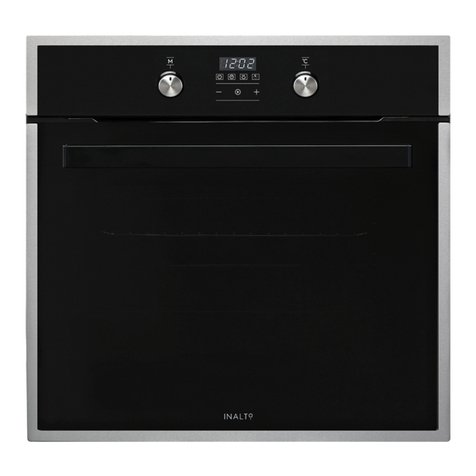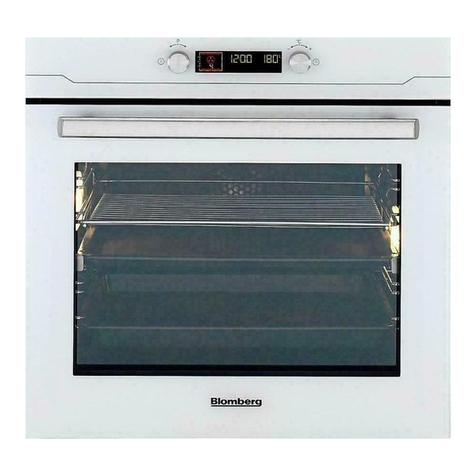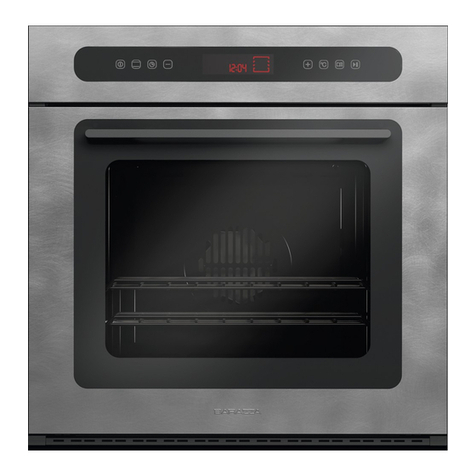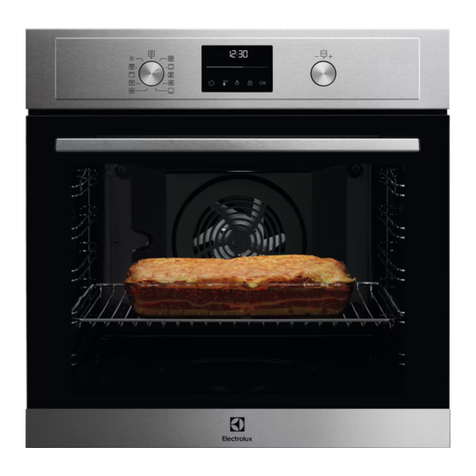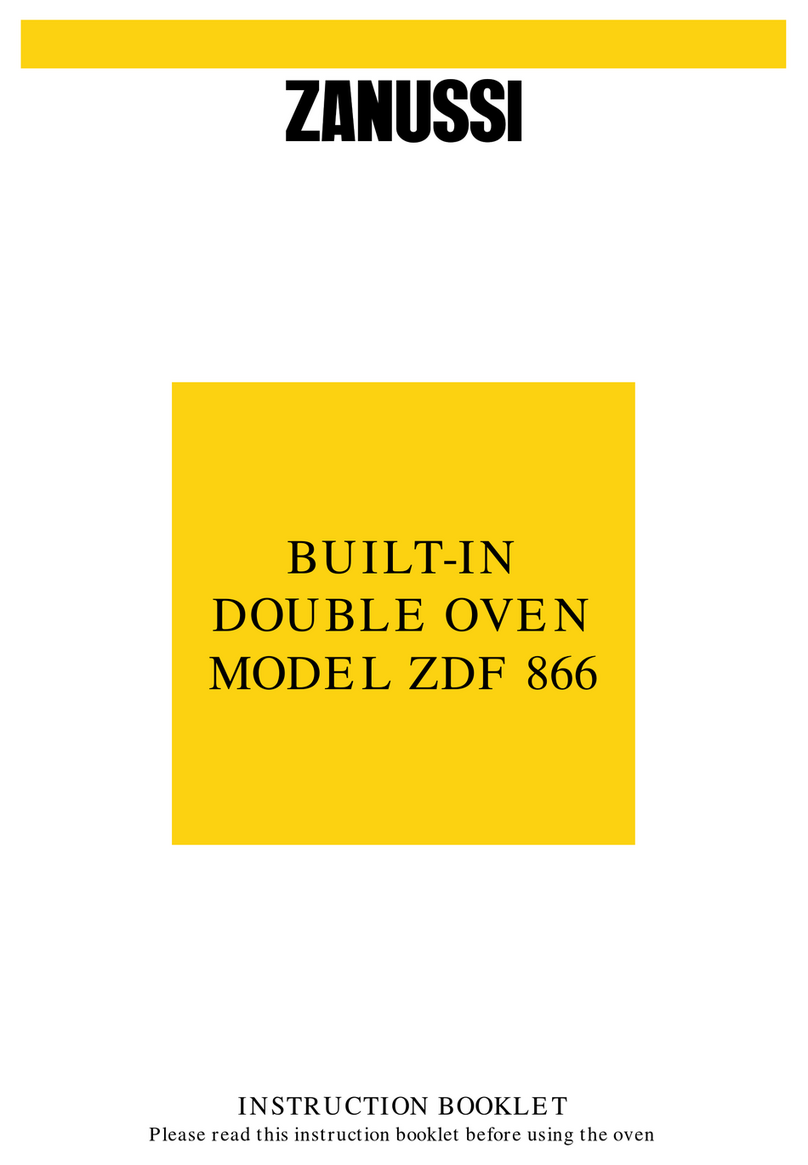Roper ELECTRIC DROP-IN D975 User manual

ROPER”
Home Appliances
OWNER’S MANUAL
ELECTRIC DROP-IN
model D975
INSTALLATION
CARE & USE
RECIPES
PART NO. 4343041 MNUOOS(343743)-3

I
THISPAGE

CONTENTS
INSTALLATION
USE AND CARE
Important Instructions for Your Safety
Your Oven and lts Features
The Electronic Oven Control
Oven Cooking
Broiling
Favorite American Recipes
The Self-Clean Cycle
Cleaning Tips
Removable Range Parts
SERVICE
Replacing Oven Light Bulbs
What to Do before Calling for Service
Adjusting Oven Temperature
WARRANTY
EC0015

INSTALLATION
IMPORTANT: Save these instructions for the local electrical inspector’s use.
TOOL LIST LOCATION
Hand or electric drill
Hand or saber saw
Pencil
Ruler or tape measure
Straight edge
l/8” drill bit
l
Put the range near a work surface for convenience.
l
The cooktop should be easy to reach and lighted with
natural light during the day.
ADDITIONAL MATERIALS
This range is designed to hang from the counter top. It does
not rest on the floor.
l
To eliminate the risk of burns or fire by reaching over
heated surface units, cabinet storage space located
above the surface units should be avoided. If cabinet
storage space is to be provided, the risk can be reduced
by installing a range hood that projects horizontally a
minimum of 5 in. beyond the bottom of the cabinets.
If countertop is less that 1-1/2”thick, reinforcing braces must
be installed under the countertop, on each side. See figure
below.
RANGE SUPPORT
l
See Figures 1 and 2 for all rough-in and spacing dimen-
sions These dimensions must be met for safe use of
your range.
l
A wiring junction box must be installed in’ an adjoining
cabinet or under the floor. The junction box must be
located where it will allow considerable slack in the 4 ft.
long range conduit, so that the range can be pulled
forward for servicing if necessary. See next page for
more information.
BRACE SCREWED TO
UNDERSIDE OF
COUNTERTOP
Adloining vertical cabinet or wall above countertop
Ins& back wall 01cabinet
1-l/2’ Mmimum 546” Minimum flat
-_~-_-
must be smooth
Exact
:ig. 1
CUTOUT TOP VIEW dimension must extend
to flat area.
flo”om
18” of cabinets on either
of cablnet above range
Fio. 2
2
EINS24-3

ELECTRICAL REQUIREMENTS
We recommend you have the electrical wiring and hookupof
your range done by a qualified electrician. After installation,
have the electrician show you where your main range
disconnect is located.
Check with your local utilities for electrical codes which apply
in your area. Failure to wire you range according to govern-
ing codes could result in a hazardous condition. If there are
no local codes, you range must be wired and fused to meet
the requirements of the National Electrical Code, ANSI/
NFPA No. 70-1987. You can get a copy by writing:
National Fire Protection Association
Batterymarch Park
Quincy, MA 02269
You must use a three-wire, single-phase A.C. 208Y/120Volt
or 120/240 Volt, 60 Hertz electrical system. If you connect
to aluminum wiring, properly installed connections approved
for use with aluminum wiring must be used.
In the absence of local codes, we recommend that a mini-
mum wire size of No. 8 copper wire and a 40 amp fuse or
circuit breaker be used, on both 208Y/120 Volt and 1201240
Volt systems.
PREPARE THE COUNTER
Install base cabinets 30” apart, and be sure they are
plumb and level before attaching the countertop.
Lay out the cutout opening on the countertop per Fig. 1.
(Countertopcutout shown in Fig. 1. assumes a standard
installation in a 25” deep counter with a standard 1-l/4”
overhang.) If theoverhang is less than 1-l/4”, the range
front side trims and control panel end caps will extend
into the 30” cutout. If the overhang is greater than
l-1/4”, a gap between the cabinet face and the range
front side trims will exist. A moulding may be fitted to
provide a more custom appearance. Before cutting,
check for dimension marked min. (Fig. 1). If these
dimensions are not met, the product can be moved
forward on the countertop until minimum dimensions are
met. (Decreasethecutoutdimensions22-13/16”&1-l/
8” by the amount of the forward movement.) This will
make the end caps extend forward in front of the
countertop and may create a gap between the range
front trims and the cabinet face. If this occurs, fit
mouldingas above. If it is not flat at the backof the notch,
the raised area must be filed or cut away to fit.
Make cutout. If the countertop is not 1-l/2” thick, install
reinforcing braces under the countertop as shown on
page 1.
Install the wiring junction box in an adjoining cabinet or
underthefloor. Cut 1-1/2”dia. hole to bringthe electrical
cable from the range to the junction box. The junction
box must be located so that there will be enough slack
in the connected cable to allow the range to be pulled
forward several inches for service if necessary.
MAKE ELECTRICAL CONNECTION
1. De-energize range branch circuit.
2. With range in front of opening, push flexible electrical
cable through hole in floor or adjacent base cabinet and
attach it to the junction box. Do not shorten this cable.
The flexible cable connector must be securely attached
to the junction box and the flexible cable must be
securely attached to the connector. If the flexible cable
will not fit within the connector, do not install the range
until a connector of the proper size is obtained.
When connecting to a 3-conductor branch circuit, if
local codes permit, connect the white and bare
ground connector leads of the range to the branch
circuit neutral (white or gray in color), the range red
lead to the branch circuit red lead and the range black
lead to the branch circuit black lead in accordance
with local codes.
Special Grounding Instructions
.
.
.
1.
2.
3.
When connecting to a 4-conductor branch circuit.
When installing range in a mobile home.
When local codes do not permit grounding through
neutral.
Attach the appliance grounding lead (green or bare
copper) to the residence grounding conductor (green or
bare) in accordance with local codes. If the residence
grounding conductor is aluminum, see “WARNING”
note below.
Connect the range neutral (white) lead to the branch
circuit neutral (white or gray) in accordance with local
codes.
Connect the range red lead to the branch circuit red lead
and the range black lead to the branch circuit black lead
in accordance with local codes. If the residence red and
black leads are aluminum conductors, see “WARNING”
note below.
NOTE TO ELECTRICIAN: The three power leads supplied
with this appliance are U-L. recognized for connection to
larger gauge household wiring. The insulation of these three
leads is rated at temperatures much higher than the tem-
perature rating of household wiring. The current carrying
capacity of a conductor is governed by the temperature
rating of the insulation around the wire rather than the wire
gauge alone.
WARNING: IMPROPER CONNECTION OF ALUMINUM
HOUSE WIRING TO THESE COPPER LEADS CAN RE-
SULT IN A SERIOUS PROBLEM. USE ONLY CONNEC-
TORS DESIGNED FOR JOINING COPPER TO ALUMI-
NUM AND FOLLOW THE MANUFACTURER’S RECOM-
MENDED PROCEDURE CLOSELY.
3 EINS29-1

INSTALL RANGE
BE SURE RANGE BRANCH CIRCUIT IS DE-
ENERGIZED. I
IMPORTANT SAFETY WARNING
1. Remove Oven Door
n
Open the door to the stop
position (see illustration).
l
Grasp the door at each side and
lift
up and off the
hinges.
NOTE: When the door is removed and hinge arms are at
stop position, do not bumportry to move the hinge arms. The
hinges could snap back causing injury to the hands Or
damage to the porcelain on the front of the range. Cover the
hinges with toweling or empty towel rolls while working in the
oven area.
Be sure to attach range to counter and
be sure counter top is securely attached
to the cabinets or wall.
A
Failure to do so could permit the range
to tip, causing injury.
STOP POSITION
To replace:
VENT TRIM
l
Hold the door over the hinges with the slots at the bottom
edge of the door lined up with the hinges. The hinge arms
must still be in the stop position.
l
Slide the door down onto the hinges as far as it will go and
close the door.
2. Position range in opening.
l
Raise lift-up cooktop and support it with cooktop
support rod.
l
Drill 118”diameter pilot holes into countertop using
holes in upper side panels. Attach range to countertop
(Fig.
4)
with screws provided in literature package.
EINS30-2

IMPORTANT INSTRUCTIONS
FOR YOUR SAFETY
Teach children not to play with range knobs CAUTION! Never store things children Never leave the oven door open when you
or any other part of the range. might want above a range. are not watching the range.
Never leave children alone or unattended Never let anyone climb, sit or stand on the Never let children sit or stand on the open
where a range is in use. open door or any other part of the oven door.
range. Their weight may make the range
tip over.
I I I
Always keepthe range areaclearand free
from things that will burn.
Never store things in an oven or near
cooktop elements/burners. These things
may catch fire and plastic items could melt.
Never use your range for warming or
healing a room. Such use could be dan-
gerous and hurt range parts.
Never let pot handles stick out over the
front of the range. Turn handles in so that
they cannot be bumped into. Keep the
handles away from other hot surface ele-
ments/burners.
Never wear loose clothing when using
your range. Such clothing could catch fire. Never use a towel or other bulky cloth as a
pot holder. Such cloths could catch fireon
a hot element/burner.
Never leavecooktop elemenWburners un-
watched at high heat settings. Boilovers
cause smoking and greasy spillovers could
catch fire.
5 ESAFOl -2

IMPORTANT SAFETY INSTRUCTIONS
Keep this book for later use.
Be sure your range is installed and grounded
properly.
Choose pots and pans with flat bottoms, large
enough to cover the entire cooktop element. This
will cut down the risk of setting pot holders or
clothing on fire with an uncovered element and
waste less energy.
Always use care when touching cooktop ele-
ments, areas near cooktop elements, oven heat-
ing elements or inside the oven. Heating ele-
ments could be hot enough to burn you even ifthey
are dark in color. The oven vent duct and oven
door may also become hot during range use.
Only some kinds of glass or ceramic pans can be
used for cooktop cooking. Be sure that the pan
you use will not break when heated on the cooktop
elements.
Always change oven rack positions while oven is
cool.
After broiling, alwaystake the broiler pan out of the
range and clean it. Leftover grease in the broiler
pan can catch on fire next time you use the pan.
Always use dry pot holders when removing pans
from the oven or cooktop. Moist or damp pot
holders can cause steam burns.
Always use care when opening oven door. Let
hot air and steam out before moving food.
Always follow cleaning instructions in this book.
Always remove the broiler pan and other utensils
from the oven before a self-clean cycle.
Never try to repair or replace any part of the range
unless instructions are given in this book. All other
work should be done by a skilled technician.
Never heat unopened food containers. Pressure
build up may make container burst and cause
injury.
Never leave jars or cans of fat or drippings on or
near the range. Never let grease build up on your
range. You can keep grease fires from starting if
you clean up grease and spills after each range
use.
Never use aluminum foil to line drip bowls or oven
bottoms. Improper use of foil could start a fire.
Never block free airflow through the oven vent.
Never try to move a pan of hot fat, especially a
deep fat fryer. Wait until the fat has cooled.
Never put removable heating elements in water.
Never use the cooktop without reflector pans or
drip bowls being in place. If these pans or bowls
are not there during cooking, wiring or other range
parts may be damaged.
Never rub, move or damage the door gasket on
self-cleaning ranges. The gasket is essential for a
good seal. Only clean the gasket by soaking it
with hydrogen peroxide, as described in the self-
clean section of the manual.
Never touch surface units, heating elements, or
interior surfaces of the oven. They may be hot
even though they appear dark in color.
COOKTOP GREASE FIRE
Never pick up a flaming pan...lnstead:
1. Turn off the element.
Read and understand this information NOW! 2. Smother the fire with a tightly fitting pan
Should you ever need it, you will not have time lid, baking soda or an extinguisher.
for reading.
OVEN FIRE
1. Close oven door and turn controls off.
Never use water on a grease fire - it will only
spread the flames. 2. If fire continues, throw baking soda on the
ESAFOZ-4

Your
Range
IMPORTANT: The model
and serial number of your
range can be found on a tag
located below the lift-up
cooktop, at the rear.
Copy the nt
box on the
manual.
Jmbers into the
cover of this
n
12
1. Lift-Up Cooktop 7. Removable Oven Door
2. Oven Vent (below right rear element; area may get
hot during oven use; DO NOT block vent) 8. Oven Door Gasket
3. Removable Cooktop Elements 9. Oven Bake Element
4. Oven Light Switch 10. Cooktop Control
5. Electronic Range Control (see next page)
6. Oven Door Latch (locks doorduring self-clean cycle;
see self-clean section for more information)
11. Cooktop Indicator Light (glows when any cooktop
element is on)
12. Removable Chrome Reflector Bowls
7 EDIF

The Electronic Range Control (ERC)
1.
2.
3.
4.
5.
6.
TIMER CLOCK TIMEsTop CLEAN ;c;
BROIL BAKE
------
OVEN CANCEL BUlTON - Cancels everything
except the clock and timer. Push this button to
turn the oven off or to clear everything if you’ve
made a mistake in programming.
DISPLAY INDICATORS - Light up to tell you
what is being shown in the TIME DISPLAY
WINDOW.
TIME DISPLAY WINDOW - Shows the time of
day or the times you set for the timer or auto-
matic oven operation.
OVEN TEMPERATURE AND BROIL DISPLAY
WINDOW - Shows the oven temperature or broil
setting you have selected.
FUNCTION INDICATORS - Light up to show
whether oven is baking, broiling or self-cleaning.
SET KNOB - Turn to set times and tempera-
tures after pushing a function button.
7-13 FUNCTION BUTTONS
7. BAKE - Push before setting bake temperature.
8. BROIL - Push before selecting BROIL setting.
6
P
9.
COOK TIME - Push before setting length of
cook time for automatic oven operations.
10. CLEAN - Push to use self-clean cycle.
11. STOP TIME - Push before selecting the time
when you want the oven to turn off for automatic
oven operations.
12. CLOCK - Push before setting clock or to bring
time of day into the TIME DISPLAY WINDOW.
13. TIMER - Push before setting amount of time.
TO SET THE CLOCK
2 Turn to set
9
time of day
CERCOl-2

To start
things
cooking
Cooktop Cooking
The sign near each cooktop control knob shows which
element is turned on by that knob. For best cooking results and energy efficient operalion, you
should use pans that:
A. Have flat bottoms and straight sides.
00 00 00 00
B. Have light handles that do not tilt pans.
C. Are about the same size as lhe element
00 00 00 oa
Left Left Right Right
Rear Front Rear Front
To operate cooktop controls:
1. Push to turn.
2. Set on or between marks for desired heat.
An indicator light will glow when any cooktop element is on When the oven is on, heated air moves through a vent under
the right rear cooktop element. This hot air may make pot
handles hot or melt plastic items left too nearthevent. The vent
is necessary for proper oven performance. Do not block it.
I I
A
Never line the bowls below cooktop
elements with alumlnum foil. Foil can
block normal heat flow, and damage the
range. This is especially true If foil
blocks the oven vent tube under the
right rear cooktop element.
COOKTOP CONTROL
9
EMTCl7-1

TO BAKE OR ROAST
Q
3
PUSH WHEN
FINISHED TURNTO 2
SET TEMP Q
TIMER CLOCK s:M4’ CLEAN FE; BROIL BAKE
-------
mmmmmm F
PUSH 1
6
The red display will show the oven temperature as it rises (in
5” steps).
A tone will sound when the oven is ready.
AUTOMATIC OVEN OFF
TURN TO SET Q
ANCEL ’ J
TIMER CLOCK s:M9’ CLEAN ;‘E” BROIL BAKE
-------
6 PUSH @ PUSH
The ERC will calculate when to turn the oven off.
When the stop time is reached, a tone will sound and the
oven will turn off I
DELAYED BAKE CYCLE
TURN TO TURN TO TURN TO
SET LENGTH SET TEMP SET OVEN
SET
J
TIMER CLOCK s:M4’ CLEAN ;y$; BROIL BAKE
-------
mm F -f--f- ,
6 6 d
PUSH PUSH PUSH
When cook time has ended, a tone will sound and the oven
will turn off.
TO USE THE TIMER
TURN TO
SET AMOUNT
2
OF TIME
0
\
TIMER CLOCK ;;M4’ CLEAN ;‘E” BROIL BAKE
-------
%----- Nmmmmm
HOLD
3 SECONDS TO CANCEL
A tone will sound when time is up.
NOTE: The timer is a reminder only and will not operate
INCOMPLETE OR INCORRECT
SETTINGS
1.
2.
Attention Tone will sound if oven has only been partially
programmed. For example, if you have selected a cook
time but no temperature, you will hear the Attention Tone
until you select a temperature or push CANCEL.
Function Error Tone will sound if there is a problem with
one of the range functions. Cancel the tone by pushing
the CANCEL button. If the tone starts again, call for
service.
RECALLING FUNCTIONS
CANCELLING TONES
If you prefer that your range not have a tone whenever you
push a button, you can eliminate those tones by pushing and
holding the CANCEL button until you hear a beep. Repeat
to activate tones again.
PREHEATING FOR AUTOMATIC OVEN
OPERATIONS
Cook times programmed for automatic oven operations start
counting down when the oven first comes on, not when it has
reached the set temperatures. It takes 10 to 15 minutes to
reach the set temperature, thus additional cook time may be
You may recall any set function by pushing the button of that necessary.
function.
10
CCTLOl-7

Broiling
0
3 Push When
Finished 0
2 G;rtfget
Broil
\
TIMER CLOCK TIMESToP CLEAN ;f; BROIL BAKE
mmmmmqm
!I
1 Push
Most foods can be broiled at the HI Broil Setting. Select the
LO Broil setting to avoid excessive browning or drying of
foods that should be cooked to the well-done stage (such as
thick pork chops or poultry).
BROILING TIPS
Your oven door should be open to the broil stop
posltlon while broiling. If the door Is closed, the food
will roast and not broil.
Use only the broiler pan and grid that came with your
range for broiling. They are designed for proper drainage
of fat and liquids and help prevent spatter, smoke or fire.
Do not preheat when brolllng. For even broiling on both
sides, start the food on a cold pan.
When broiling frozen meat, use one rack position lower
than recommended and up to 1 l/2 times the suggested
broiling time.
Trim the outer layer of fat from steaks and chops. Slit the
fatty edges to keep the meat from curling.
For maximum juiciness, salt the first side just before
turning the meat. Salt the second side just before serving.
Brush chicken and fish with butter several times as they
broil. When broiling fish, grease the grid to keep it from
sticking and broil with skin side down. It is not necessary
to turn fish.
Never leave a solled broiler pan In the range. Grease
in the pan may smoke or burn the next time the oven is
use.
Be sure you know the correct procedure for putting
out a grease flre. See the section on safety.
A
Do not cover the entlre broller grld with
foil. Poor drainage of hot fat may cause
a broiler flre.
If a fire starts, close the oven door and
turn controls off. If flre continues, throw
baklng soda on the flre. Do not put water
on the flre.
POSITIONING BROILER PAN
Broiling is cooking by direct heat from the broil element.
Tender cuts of meat or marinated meat should be selected
for broiling. For best results steaks should be at least 3/4”
thick.
After placing food on the broiler pan, put the pan
on an oven
rack in the proper position. The recommended rack position
and cooking time can be found in the chart below
The closer the food is to the broil element, the faster the meat
browns on the outside, yet stays red to pink in the center.
Moving the meat farther away from the element letsthe meat
cook to the center while browning outside. Side one should
be cooked 1 - 2 minutes longer than side two.
I
Rack I
Food Position Total Time
4 = Hlghest (mlnutes)
1 = Lowest
I
Steak - 1” Thick
I I I
Medium-l” Thick 3 16-18
Medium-l/2” Thick 4 7-9
Lamb Chops - 1" Thick 3 18-21
Pork Chops - 1” Thick 3 27-29
Pork Chops l/2” Thick 3 16-18
Ham Slice - 1/2”Thick 3 11-12
Fish (Fillets) 3 11-13
Chicken ( Pieces) 2 45-55
Frankfurters 3 8-11
Bacon 3 9-11
This chart is a general guide. The size, weight, thickness,
and starting temperature of the food as well as your own
personal preference will affect the cooking time. Times in the
char-l are based on the food being at refrigerator tempera-
ture.
11
EBRLOl-3

Oven Cooking
. Always follow recipe carefully.
. Measure ingredients properly.
. Use proper pan placement.
. Place pans on the oven racks with 1
-l/2
- 2” of air space
on all sides of each pan. Avoid overcrowding the oven.
. Pans too close to each other, to oven walls or to the oven
bottom, block the free movement of air. Improper air
movement causes uneven browning and cooking.
2 cake layers
4
cake layers
Let the oven preheat thoroughly before cooking baked
products. Allow 10 - 15 minutes preheat time.
Avoid opening the door too often to check the food
during baking as heat will be lost. This may result in poor
baking results.
Cakes, cookies, muffins, and quick breads should be
baked in shiny pans - to reflect the heat - because
they should have a light golden crust. Yeast breads and
pie crusts should be baked in glass or dull (non-shiny)
pans -to absorb the heat-because they should have
a brown, crisp crust.
Oven temperatures should be reduced 25 degrees
below recommended temperatures if you use dark pans
or oven proof glass.
There may be some odor when the oven is first used.
This is caused by the heating of new parts and insula-
tion
Do not cover the oven bottom or an entire oven rack with
foil. The foil can block normal heat flow, cause cooking
failures, and damage the oven interior.
. Most baking should be done on the second shelf position
from the bottom. When baking several items, use two
shelves placed on the second and fourth rack positions
fromthe bottomoftheoven. Staggerpanssothat nopan
is directly above another. Bake angel food cakes on the
first shelf position from the bottom of the oven.
12
covco1-I

Favorite American Recipes
A Collection from Around the Country
LAZY-DAY COFFEE CAKE
3/4 cup margarine, softened
1 cup sugar
2
eggs
1 cup sour cream
2 cups all-purpose flour
1 teaspoon baking powder
1 teaspoon soda
l/2 teaspoon salt
1 teaspoon nutmeg
3/4 cup light brown sugar
l/2 cup chopped pecans
7 teaspoon cinnamon
Cream margarine and sugar until light and fluffy. Add eggs and sour cream; mix well. Combine flour, baking powder, soda,
salt and nutmeg. Add to batter and mix well. Pour batter into greased and floured 13” x 9” x 2” baking pan.
Combine brown sugar, pecans and cinnamon; mix well. Sprinkle one half of this mixture over cake batter; swirl mixture
through batter. Sprinkle remaining one half mixture evenly over cake batter,
Cover and chill overnight. Uncover and bake in preheated 350” F oven for 35 to 45 minutes or until cake tests done with
toothpick.
BROCCOLI CASSEROLE
2 - 70 oz. pkg. frozen chopped broccoli
7 cup mayonnaise
1 cup sharp cheddar cheese, grated
2 eggs, beaten slightly
1 can cream of mushroom soup
2 tablespoons chopped onion
1 cup cheese cracker crumbs
Preheat oven to 375” F. Cook broccoli according to package directions: drain.
Mix with other ingredients. Pour into greased two (2) quart casserole. Sprinkle
with cheese cracker crumbs. Bake at 375” F for 20-25 minutes.
SOUTHERN BRUNSWICK STEW
A delicious quick-to-make hearty stew that will feed a crowd or feed the family. Refrigerate or freeze the remainder for
another day.
1 - 10 oz. can barbecue beef
1 - 70 oz. can barbecue pork
1 - 24 oz. can Brunswick slew
1 - 5 oz. can boneless chicken
7 - 12 oz. can vacuum packed corn niblets
1 - 16 oz. can baby lima beans, drained
2 - 16 oz. cans stewed lomaloes
7 - 74% oz. can sliced okra, drained
Drain okra and lima beans. Add to all other ingredients in 4 quart
pan. Heat on medium to serving temperature.
13 CRCPOl-1

TWO CORN CASSEROLE
l/2 cup margarine
314 cup chopped green pepper
l/3 cup chopped onion
3 eggs, well beaten
17 oz. can cream style corn
17 oz. can whole kernel corn with liquid
8’12oz. pkg. corn muffin mix
1 cup cheddar cheese, shredded
Preheat oven to 350” F. Saute green peppers and onion in margarine; combine
with remaining ingredients except cheese. Pour into greased two (2) quart cas-
serole; sprinkle with cheese and bake 45-55 minutes in 350°F oven. Let stand 5
minutes before serving.
Courlesy: Iff~noisCooperafive Exfension Homemakers
FUDGE PIE
2 - 7 oz. squares semi-sweet chocolate
7 stick margarine
1 cup sugar
114 cup flour
2
ems
7 tsp. vanilla
Dash- salt
l/2 cup chopped pecans
Frozen 9” pie shell
Preheat oven to 350°F. Melt chocolate and margarine. Add other
ingredients to melted mixture. Pour into unbaked pie shell and
bake 35-40 minutes or until pie appears set. Serve warm with ice
cream or whipped cream.
APPLE DESSERT
1 - 20 oz. can apple pie filling
l/2 cup sugar
1 - 9 oz. box white cake mix (1 layer size)
1 stick margarine, melted
l/2 cup chopped pecans
Preheat oven to 350°F. Place in layers in greased 9” or 10” square baking dish:
apples, sugar, dry cake mix. Pour melted margarine over top of cake mix. Bake
at 350°F for 35 minutes. Sprinkle with pecans. Continue baking 15 minutes.
Serve warm.
GLORIFIED CORN BREAD
1 cup self-rising corn meal
l/2 cup sour cream
Place approximately 2 tablespoons cook-
skillet or 8” or 9” square baking pan. Place
hot oven until oil is hot. Tilt pan to coat bottom evenly. Mix
all ingredients. Pour mixture into hot greased pan. Bake 2G25
minutes or until golden brown.
14 CRCP02-1

The Self-Clean Cycle
BEFORE A CLEAN CYCLE
1. Remove the broil pan and grid, oven racks, all utensils and
anyfoilthat maybeintheoven. Donottrytocleanutensils
or any other objects in the oven during a self-clean cycle.
Ifoven racks are left in the range during a clean cycle, they
will darken, lose their luster and become hard to slide. If
you choose to leave the racks in the oven, you can polish
the edges of the racks with steel wool and apply a small
amount of vegetable oil to the rack edges after the self-
clean cycle. This will make the racks easier to slide.
2. Soil on the oven front frame, under the front edge of the
cooktop, the door liner outside the door seal and the front
edge of the oven cavity (about 1” into the oven) will not be
cleaned during a clean cycle (see illustration below).
Clean these areas by hand before starting a clean cycle.
tise hot waterwith a soap-filled steel wool pad, then rinse
well
FRONT FRAME
-~~~... J- -
DOOR SEAL
‘DOOR LINER
\
4. Clean the door seal by using a clean sponge to soak the
soiled area with hydrogen peroxide. Repeated soaking
may be needed depending on the amount of soil. Frequent
cleaning wi!l help prevent excessive soil build up. Do not
rub the door seal. The fiberglass material of the seal has
an extremely low resistance to abrasion. An intact and
well fitting oven door seal is essential for energy efficient
oven operation and good baking results. If you notice the
seal becoming worn, frayed or damaged in any way or if
it has become displaced on the door, you should replace
the seal.
AFTER A CLEAN CYCLE
After a clean cycle, you may notice some white ash in the
oven. Just wipe it up with a damp cloth.
If white spots remain, remove them with a soap-filled steel
wool pad. Be sure to rinse thoroughly with a vinegar and
water mixture. These deposits are usually a salt residue that
cannot be removed by the clean cycle.
If the oven is not clean after one clean cycle, the cycle may
be repeated.
PORCELAIN ENAMELED
BOWLS (some models)
Some ranges have grey porcelain enameled cooklop ele-
ment bowls. The bowls can be cleaned in the oven during the
self-clean cycle. Place them on the oven racks.
3. Wipe up heavy spillovers on the oven bottom. Too much Do not put the chrome trim rings in the oven. Doing so will
soil may cause smoking during the clean cycle. discolor and warp them.
IMPORTANT SAFETY
INFORMATION
Do not use oven cleaner. Listen for fan. A fan noise
should be heard sometime during the clean cycle. If not,
call the serviceman before self-cleaning again. If the
self-cleaning mode rhalfunctions, turn off and discon-
nect the power supply. Have serviced by a qualified
technician.
15
ESCLol-2

TO SET SELF-CLEAN
CYCLE (some models) TO INTERRUPT A CLEAN
CYCLE
1 PUSH
P
4NCEL
L-“5 ~~.~~__.___.
TIMER CLOCK ;;M4’ CLEAN COOK
TIME BROIL BAKE
-----
mm- mmmm
A
1 PUSH
Be sure oven door is closed.
The door locks automatically after the controls are set
The self-clean cycle lasts 3-1/2 hours
When the oven reaches locking temperature the word LOCK
WIIIbe shown in the ERC display.
You can push STOP TIME BUTTON to find out when the
sycle will end. Push CLEAN BUTTON to return to count
down.
WHEN A CLEAN CYCLE IS
FINISHED
WAIT UNTIL 1
LOCK GOES OUT
(20-30 minutes) P
TIMER CLOCK ;M9’ CLEAN COOK
T,ME BROIL BAKE
Y----L:
m~m!!!!mmmmm
After a clean cycle, the oven door cannot be opened unless
the word LOCK is off in the ERC display and the oven has
cooled. If you cannot open the door immediately after the
word LOCK goes off, wait about one minute and try again.
TIMER CLOCK ;;; CLEAN T;; BROIL BAKE
-------
B!!ememEme
Then follow instructions under WHEN A CLEAN CYCLE IS
FINISHED.
TO SET DELAY SELF-CLEAN
CYCLE
TURN
TO SET OVEN
TURN OFF TIME ~TURN 1/2
7 TURN
\
CANCEL \CANCEL \
TIMER CLOCK ;;M4’ CLEAN TiEK BROIL BAKETIMER CLOCK ;;M4’ CLEAN TiEK BROIL BAKE
---e-p----e-p-
mmvymmmmmvymmm ----
STOPTIMEmust be morethan3-112 hourslaterthancurrent
time of day
You can press and hold CLEAN button to find out when clean
cycle will start.
INCOMPLETE SETTINGS
Attention Tone will sound If CLEAN button is pushed and
SET knob is not turned.
Display will show “door” if the oven door is not fully closed.
Close the door and the cycle WIIIresume.
16
CSCLO3-2

Cleaning Tips
On the following pages, all removable parts on your range
are shown. Refer to those pages when cleaning your range.
Warm,
water.
a mild detergent and a soft cloth are safe to use
on all cleanable parts of your range. All-purpose cleaners,
such as FantastikB, can also be used.
Do not use metal scouring pads, except where recom-
mended.
Range cooktop finishes will be either porcelain enamel or
brushed chrome. Porcelain enamel looks like a painted
surface. Brushed chrome has a metallic appearance.
PART CLEANING MATERIALS
Control panel knobs Detergent, warm water, soft cloth
REMARKS
Do not use abrasive cleaners. Knobs pull off for
easier cleaning.
Porcelain enameled cooktop, Detergent, warm water, plastic or nylon Clean aftereach spillover. Rubchrome bowlsgently
chrome reflector bowls scouring pad with scouring pad. Soak stubborn soil.
Brushed chrome cooktop
(some models) Detergent, warm water, soft clolh or achrome Do not scourchrome tops. Stubborn stains may be
cleaner or Cooktop Cleaning Creme removed by using Espree Magwheel Cleaner@ or
Turtle Wax Polishing Compound@. To remove fin-
ger prints on brushed chrome, apply a little baby oil
with a paper towel. Rub in the direction of the brush
marks. Armor All Protectant@ can also be used
(after cleaning). Be sure to clean spills of acidic
foods quickly. Vinegar spills can permanently stain
chrome.
If cleaning methods described above prove ineffective, baked-on food residue or stains on
chrome
cooktops
can be removed by using Dadtype oven cleaners. Use
extreme caution.
Oven cleaners
are caustic and will damage painted or aluminum surfaces, such as range sides, backguard or control
panels, Do
not
use spray type oven cleaners. Overspray will damage nearby painted surfaces and
heating elements, Use several layers of newspaper and masking tape to cover surfaces such as the
backguard, control panel, range sides, countertops, etc. Remove cooktop elements (except solid
disk elements), burner bowls, grates, etc. Apply the atype oven cleaner evenly to the entire top
surface, The entire top must be cleaned to keep the finish consistent in color. Use
extreme caution
to prevent the oven cleaner from coming in contact with any other surface. Let the cleaner remain
on the top for 20-30 minutes. Rinse the top well to
remove every trace
of oven cleaner. Dry the top
and apply Armor All Protectant@ to protect the finish.
Glass Glass cleaner and paper towels Remove stubborn soil with paste of baking soda
and water. Do not use abrasive cleaners. Rinse
thoroughly.
Self-cleaning oven finish Detergent, warm water, scouring pad or
soap-filled steel wool pad or oven cleaner Rinse thoroughly after cleaning. Cleaning inside
the oven need only be done as an optional touchup
between self-clean cycles. See the self-cleaning
oven section of this manual for more information.
Oven door gasket Hydrogen peroxide Soak with hydrogen peroxide, using a sponge.
Frequent soaking helps provent soil build-up. Do
not rub. See self-cleaning se&on for more infor-
mation.
Broil pan and grid Detergent and water, scouring pad Do not leave in oven to cool. If you clean imme-
diately, the soil will steam loose while you are
eating. Remove pan from oven and empty drip-
pings. Sprinkle pan with detergent. Cover with
a wet paper towel and soak. Later, wash in sink
or dishwasher.
Porcelain enameled bowls
(some models) Can be cleaned in the oven during the clean
cycle. Place them on the oven racks. Do not put
the chrome trim rings in the oven.
I7 ECCH03-5

REMOVABLE KNOBS
All control knobs may be removed for easy cleaning by
pulling the knob straight off the stem. Be sure that the knob
is in the OFF position before removal.
Hint: Slip a thin cloth (such as a handkerchief) or a piece of
string under and around the knob edge and pull up.
Cautlon: Read these instructions carefully before
replaclng the knobs. Replacing the knobs Improperly
will damage the knobs and the spring clip on the
Stems.
If this happens, the knobs will flt loosely.
To replace the knob:
1. The knob stem has a groove in each side. The groove on
one side has a spring clip. The other groove is clear (see
illustration).
2. Check the inside of the knob and find the molded rib.
3. Replace the knob by fitting the molded rib inside the knob
into the clear groove on the stem.
MOLDED
I
CLEAR
GROOVE IN STEM
REMOVABLE COOKTOP UNITS
The cooktop elements can be unplugged and the bowls
removed for cleaning.
Be sure all cooktop unlt control knobsare turned off and
elementsarecoolbeforeyouremoveorreplaceacooktop
unit.
To remove:
1. Grasp element, tilt it upward slightly to clear the bowl, then
pull away from the receptacle. The element will not sit
level when replaced if it is forced too far upward when
removed.
2. For models with porcelain enameled reflector bowls,
remove the chrome trim ring. See the Self-Cleaning
Section about.informationon cleaning porcelain enameled
reflector bowls in self clean cycle.
3. Lift out the bowl.
Do not put the element into water. It cleans itself when
heated during normal use.
To replace:
1. Replace the bowl. Be sure the receptacle is showing in the
bowl opening.
2. For models with porcelain enameled reflector bowls,
replace chrome trim ring.
3. Slide the plug of the element firmly into the receptacle and
lower the element into place.
IMPORTANT: Never operate a cooktop element without
the bowl In place. Thls can cause scorching of the
cooktop, burning of wlrlng Insulation and lossof energy.
ELEMENT
REFLECTOR BOWLS RECEPTACLE
18 EMNT07
Table of contents
Other Roper Oven manuals
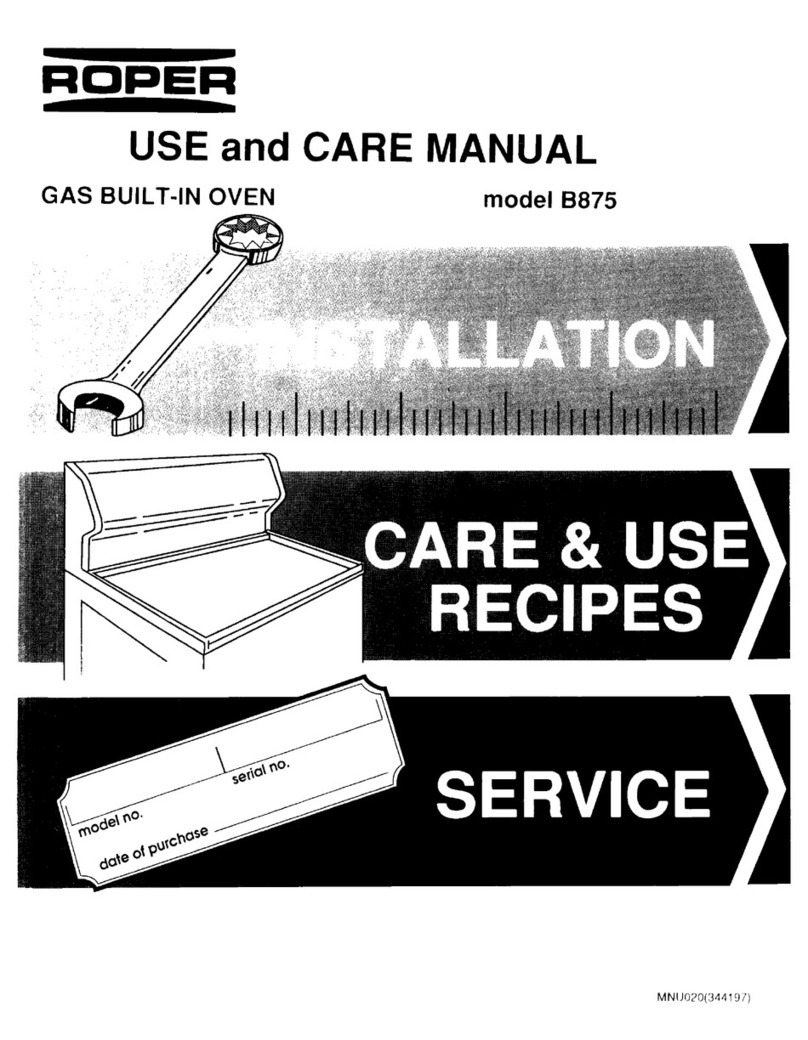
Roper
Roper B875 User manual

Roper
Roper B9907X0 User manual

Roper
Roper B400 User manual
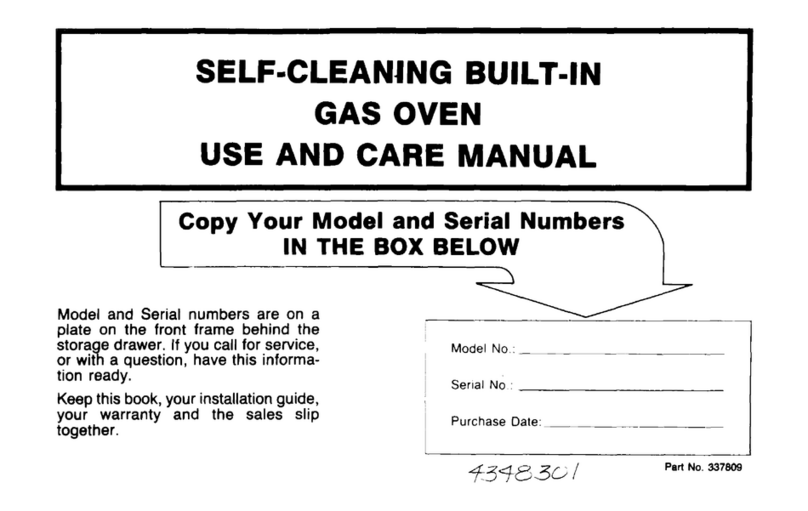
Roper
Roper B8758B0 User manual
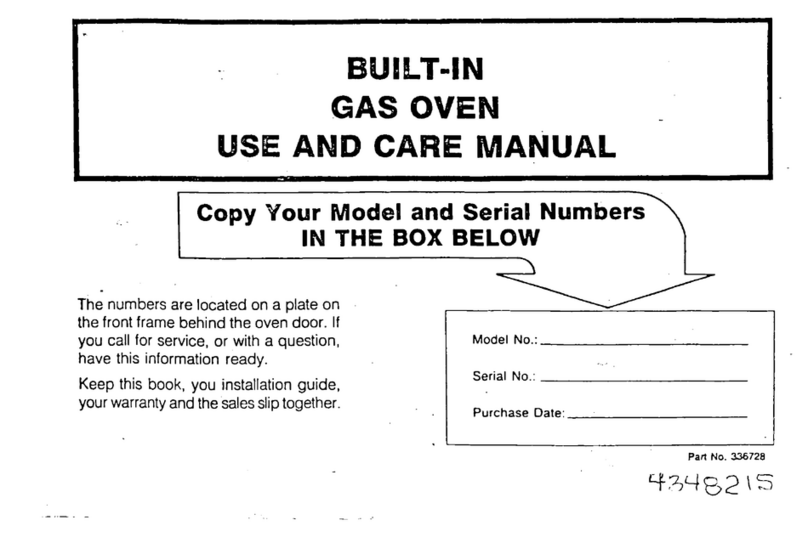
Roper
Roper B4607B0 User manual
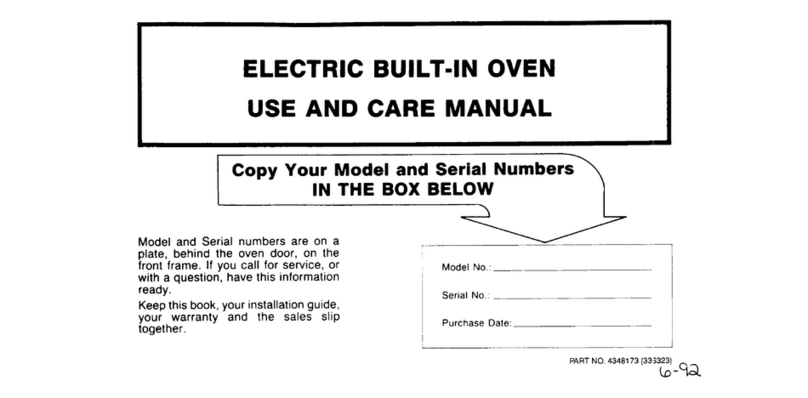
Roper
Roper B5007X0 User manual

Roper
Roper Convection Oven User manual

Roper
Roper B500 User manual
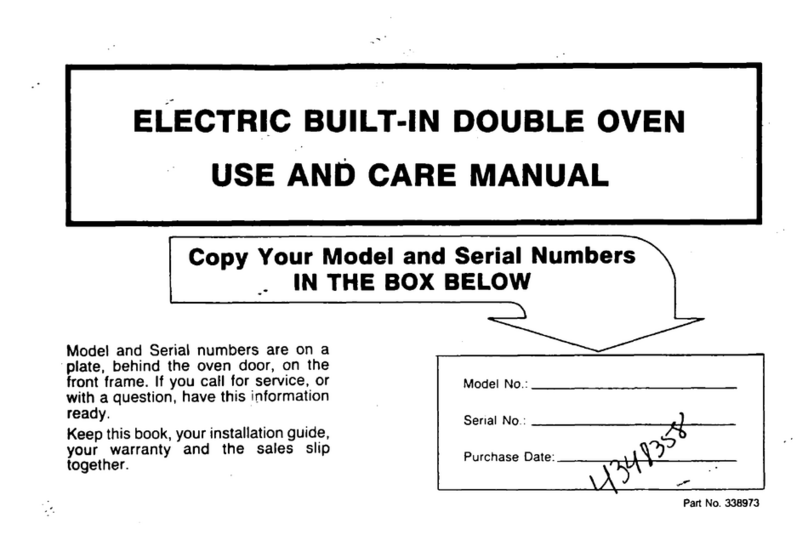
Roper
Roper B9758B0 User manual
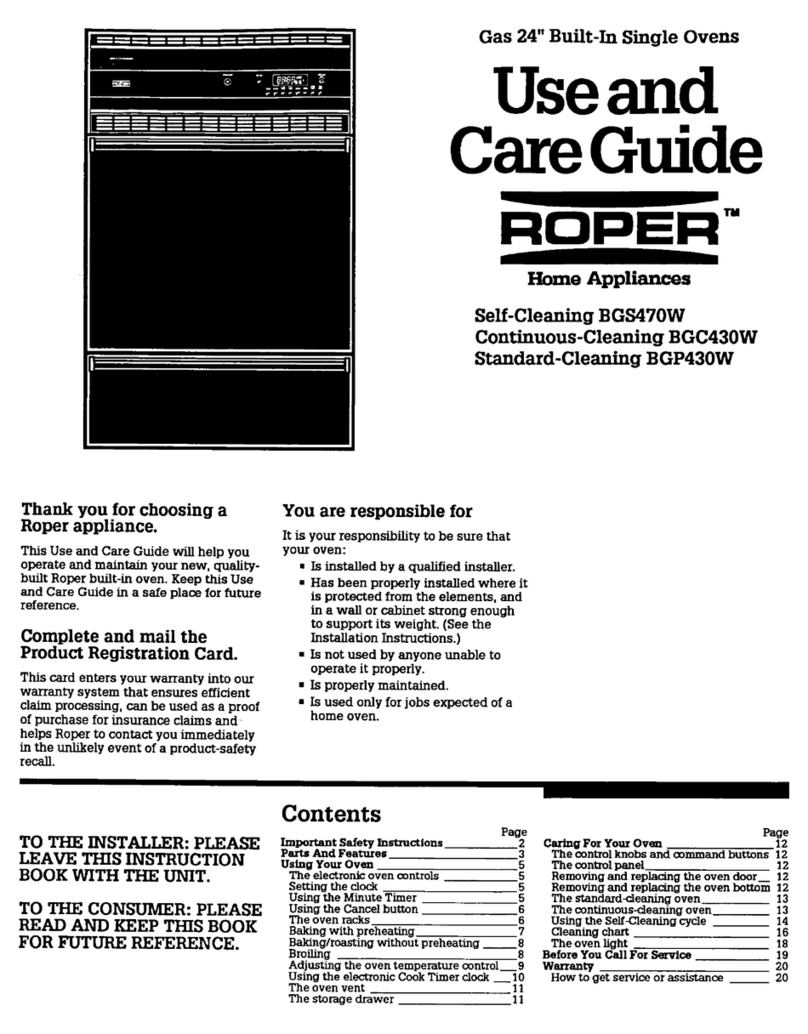
Roper
Roper BGC430W BGP430W User manual



